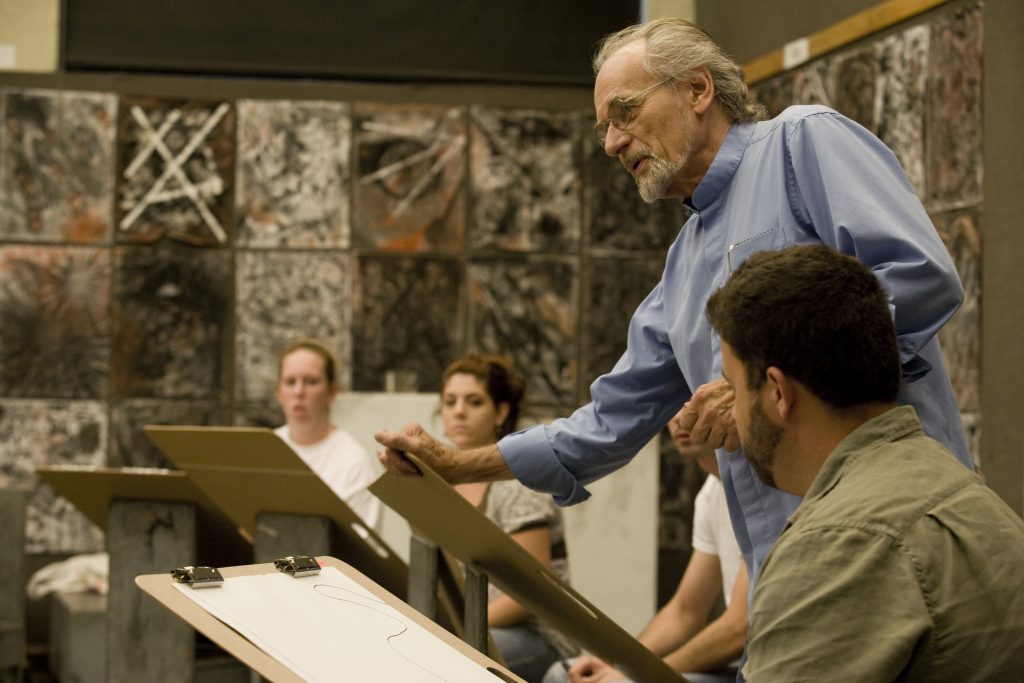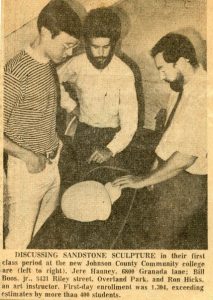Find this story in The Campus Ledger’s 2019 fall semester print edition!

In the 2019 Spring Semester, the new FADS (Fine Arts & Design Studios) was completed. The building brings film, photography, fine art and commercial art together in a 37,000 square foot space and cost $19.2 million to build. The fine art faculty invested 50 years of teaching equity in building the fine art’s program foundation.
The college conducted their first classes in leased facilities in Johnson County in the fall of 1969. The initial enrollment was 1380 students. Ronald D. Hicks, a former high school art teacher from Shawnee Mission East High School was the first art instructor at the college. According to Hicks, the main campus headquarters was an old elementary school and the first painting, drawing, sculpture and humanities classes were taught in a house, automotive shop and church in Merriam.
Enrollment across disciplines exceeded initial projections by over 400 students. Dorothy Wadsworth, an artist doing graphic design work for the college, was recruited as a full-time commercial art instructor. Jean Howard was hired to teach part-time. Within three years, she was the full-time painting and drawing instructor.
The art faculty was consulted regarding the specific logistical and safety needs of the fine art department. According to Hicks, the original plan was to have an art building, but due to a big push for technologies at the time, the Arts and Technology Building (ATB) was built and combined the two when the college moved to their current location in 1972. Hicks said, the studios in ATB were too small and the size and placement of the offices were an after-thought, but the biggest disappointment was that their health and safety concerns were not deemed adequate to implement modifications to the space.
Hicks set up the sculpture, metalsmithing and ceramics studios as more faculty were hired specializing in ceramics. Hicks was one of two people at the college to first have a computer and implement computer technology in his teaching. Hicks said, his strengths as a teacher included his humorous, patient and individualized teaching style and innate curiosity and problem-solving skills and that Howard’s skills perfectly complimented his.
“I taught painting and drawing, then added life drawing and watercolor later,” Howard said. “…my goal was to teach [students] critical thinking, problem solving skills and how to really see, that is what I was doing.”
Howard set up the original drawing and painting studios in ATB, navigated the politics and saw to it that students’ credit hours were transferable and met four-year college requirements.
Landon Kirchner, assistant dean of arts, humanities and social sciences, had a vision to elevate and diversify the arts education and make art more accessible on campus.
He hired artist Zigmunds Priede, a renowned print-maker and master printer, in 1983 as part of that initiative. According to Kirchner, Priede was the cornerstone of quality and standard of the Visual Arts Education and public art.

“The board gave us certain outlines and we as a faculty got together and agreed to meet certain objectives, but it was open enough to allow for our individuality,” Priede said. “The projects were fundamental enough that they could be understood and accomplished by a diverse group of students.”
Priede was on the first art acquisitions committee and was instrumental in establishing the original public art collection and first Gallery of Art.
“What you learn from books or what you learn from film projections is one thing, but there is nothing better than going and seeing the real work,“ Priede said. “Go to museums, go to artists’ studios, talk to them, get to raise questions, that is what it is about and the more you have that kind of exposure the better.”
Priede retired in 2005 but came back to teach drawing as an adjunct professor from 2008-2013.
Larry Thomas came to the college in 1991 and later became the chair of fine arts and photography department. Before becoming chair, one of his main focuses was acquiring a new building for fine arts.
“The ATB was becoming inadequate for our needs and the ventilation had always been a problem in that building,” Thomas said. “The only other thing I wanted to accomplish, and I think this is the most important, was to maintain a Fine Arts Department that would carry on the reputation it had had for many years. We have always had high praise from colleges where our students transferred to after leaving [the college]. Giving students the best art education [we] could was my primary goal.”

To creating a long-lasting Fine Arts Department, Thomas knew he had to incorporate modern technology into the curriculum. In 1998, he created the Digital Imaging for Artists I & II and taught at least one section of it until his retirement in 2016. With video becoming more popular Thomas wanted to incorporate it into the curriculum. The college hired Tonia Hughes, associate professor of photography and film-making, the year he retired.
However, the inclusion of film-making and plans for a new building weren’t the only changes in the works as social norms began to change and equality for all became a powerful movement. Bridget Stewart, adjunct professor of art, has been teaching classes through the
Fine Arts Department at the college since 2005. She attended the college as a student in the early 1980s and has witnessed the evolution of the arts program and culture, particularly for women in art.
“I had only three women instructors in undergraduate art school and only two in graduate art school,” Stewart said. “I witnessed and experienced blatant discrimination against me as a woman in my studies….But now, I walk into a building to teach in which I am just one of 12 female art faculty members. Women are regularly shown as vital contemporary artists in the Nerman Museum next door and are well-represented in its permanent collection…. All of this leads to a more diverse, mindful, interesting, dynamic and robust educational atmosphere. And, it portends a stronger platform for women ahead as they pursue their passions for art and arts education.”
The FADS building itself does more than give fine art and design students more space to work, though. The building gives “spaces to match the talents of our employees” according to Jim Lane, dean of arts and design, humanities and social sciences. According to Stewart, “the FADS building has solidified the importance of the arts at [the college].”

“The consolidation of the Design Department with the [fine art, photography and film departments] within the FADS building allows for students in all departments to take new classes, experience new kinds of media and flourish within the atmosphere of creativity,” Stewart continued.
Thomas thinks the new building is beautiful and hopes it will help the college recruit new students. He is happy to finally see fine arts, photography, film and graphic design in the same building.
“I hope the department maintains its commitment to high standards in art education and continues to develop curriculum that is current with the times,” Thomas said. “I hope the administration will sustain its commitment to the department. The college has a stellar reputation in regards to the arts and I truly hope it perseveres through good times and bad. I still know most of the faculty in the department and am confident they will make the department even better in the future.”
Story by Penny Thieme






















